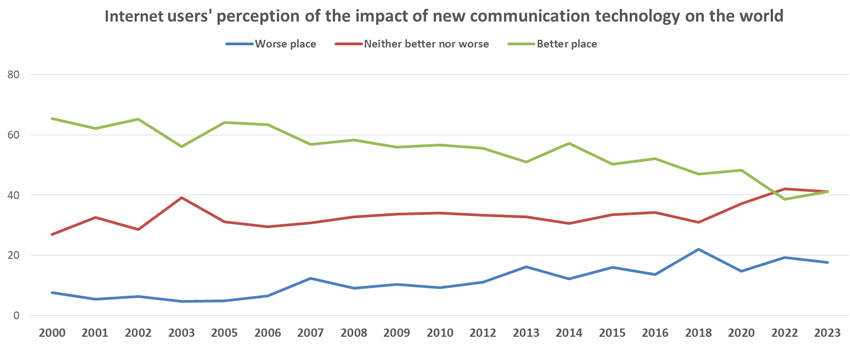Does the internet make the world a better place?
Center founder and director Jeffrey Cole explores what we’ve learned from asking the World Internet Project’s signature question for 25 years.
By Jeffrey Cole
The World Internet Project (WIP) is about to turn 25 and is more vital than ever. In 1998, we believed that the internet would change the world, that practically every activity would be affected, and that most would be transformed. Although our predictions seemed excessive at the time, they turned out to be tame compared to the reality.
Our plan was to organize partners around the world and track digital developments in a way that had never been done for television: the most powerful media before the internet. At last count, we have thirty global partners. We have completely captured the rise of broadband, social media, smartphones, and—most recently—artificial intelligence.
WIP is the longest longitudinal study of the internet in the world.
While the focus of the project has evolved from early issues like digital divides, privacy, and ecommerce, there are a few things we have continued to track for all 25 years.
In future columns, I will examine how a few of the foundational questions changed as the internet grew from a digital novelty to an essential part of everyday life.
Only WIP can produce this kind of data. Now, a quarter of a century later , the story is so compelling that we want to share it.
As we put the first questions together in 1999, we wanted a bellwether question similar to Gallup and Roper that would take the temperature of people’s views of new technology.
Here is the original form of the final question in the first survey:
Overall, do you think that new communications technologies such as internet, pagers, and cell phones have made the world a better place, a worse place, or neither better nor worse?
Over the years, the wording of the question (but not the intent) had to change. By 2008, pagers no longer made any sense (they had almost completely disappeared) and we had to add social media and tablets.

Credit: Center for the Digital Future
Let’s take a walk through 25 years of tracking this question. As other partners joined the project they began asking about making the world a better or worse place. Only the U.S. team has tracked this data for 25 years. That data is highlighted below.
The Optimistic Phase: 1999 to 2006
When we first asked the question in 1999-2000, people were hopeful about how all this new technology would make our lives better. The internet was connecting people, making communication more efficient, and making much of the world’s information easily accessible, so people were excited and optimistic. In 2000, 2/3 of us thought communications technology would make the world a better place. Only eight percent were fearful that it would make life worse. The remaining 27 percent believed it would not make a different in our lives.
The following year (2001), those who saw negative effects dropped three points to five percent, the lowest negative feelings had been in the entire survey. (We saw the same five percent in 2003).
The data for 2001-2002 came in after 9/11, which our work showed had an important impact on how people viewed technology. Parents saw mobile phones as critical in reaching their children and loved ones who were out of the home during an emergency. Americans saw the internet as an important source of information—as important and more immediately accessible than television.
The opinion that communications technology would make the world better reached its highest point in 2002 at 65% (tying 2000). It never reached this peak again. At the same time, negative views of the internet reached their lowest point from 2003 to 2005, and then rose significantly.
Our plan was to organize partners around the world and track digital developments in a way that had never been done for television: the most powerful media before the internet. At last count, we have thirty global partners. We have completely captured the rise of broadband, social media, smartphones, and—most recently—artificial intelligence.
Two things in the 2003 to 2005 period affected our perception of the impact of technology: the rise of broadband integrating the internet into our lives, and the emergence of social media, first MySpace and then Facebook. At their beginnings, we saw social media as overwhelmingly positive in helping us staying better connected with family, finding old friends from high school or other places, and discovering people who shared our hobbies, political thoughts, and other interests.
A negative turn: 2008 to 2016
The positive attitude toward digital technology began to lose steam around 2007-2008. This was the beginning of the Great Recession, which may have made some services financially out of reach. More importantly, this is when we began to see our initial enthusiasm for the internet wane as we watched our privacy invaded and the rise of scams and bullying, particularly for teenagers.
From 2000 to 2009, those who felt technology was making the world a better place dropped nine points from 65 percent to 56 percent. A couple of those points shifted to making the world worse, but most of the change moved to neither.
By 2010 social media had become an essential part of the lives of almost all users, especially teenagers. Feature phones quickly disappeared, replaced by smartphones that made desktop or laptop computers less important for most users. Smartphones became the first screen; tablets became the second.
Attitudes toward technology were fairly stable from 2008 to 2012, when another shift began.
This was when we first saw the impact of the lack of online civility. We realized that teen mental health was becoming a national crisis because of continued bullying and poor self-images (especially for girls) coming from comparing themselves to highly-retouched models online. Everyone else seemed to be having a better life than us on social media.
In 2013, those who believed technology made the world a better place dropped to its lowest point: 51 percent. Almost half felt the impact of the internet was negative or neutral. Those numbers stayed relatively stable from 2013 to 2016.
Incivility ascending: 2017 to the present
Another significant drop in seeing digital as a positive force became clear in 2017 and 2018. While this data captures Donald Trump’s move into the White House, more was happening than just that.
Rightly or wrongly, we blamed the internet for the rise of misinformation and political divisiveness. On our phones and bigger screens, we saw discourse turn uncivil and ugly. We also saw screen addiction consume the lives of many Americans, especially the young. After 2017, it was difficult for many users to see anything besides the negative effects of communications technology.
Even during COVID, when the internet and smartphones became lifelines as the nations was stuck at home during lockdown, anxious about our health and the future, we focused on the negative impact of technology. Those numbers stayed low even as COVID ended, and we came back outside to resume our “normal” lives.
In 2023, only 41 percent held the belief that communications technology made the world a better place. This is down a full 24 points since we began tracking the question in 2000. Fifty-nine percent felt the effects were negative or neutral.
This is a remarkable drop. Our attitudes deteriorated from hopeful in 2000 in an almost continuous decline. At the beginning of the new century, we focused on all the ways the internet and mobile technology would enhance our lives and productivity. Within a few years that hope morphed into fear and skepticism. It is a remarkable story.
And this story is not over. We will continue tracking. A long time ago, I was asked when the World Internet Project would call it quits. I had a simple answer: when it stops being interesting.
By that standard, we will be tracking this and other questions for many years to come.
____________

Jeffrey Cole is the founder and director of The Center for the Digital Future at USC Annenberg.
See all columns from the center.
February 21, 2024

